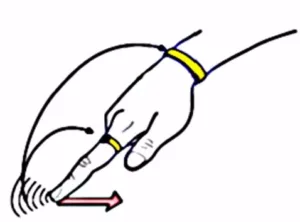Here are two problems. The first is that some devices (think smartwatches and wristbands) have a display screen with a really small surface area. The limiting case of this condition is the smart glass / HMD in which there is no physical display screen at all.

Many such small wearable devices are also physically oriented such that it is difficult to implement the kinds of touch inputs commonly used with ease in conjunction with larger devices (think smartphones and tablets).
The second problem is that the means of interface to remote displays (think TVs) can be problematical. If the interface is a simple remote control, then sending an instruction may require considerable manipulation of the controller. If the remote control is itself complex, having lots of buttons up to even a full keyboard, then, once again, the interface can be complex. Two recent patent applications filed by Microsoft provide some details on an approach under consideration by the company to address both these issues. The approach is based on having the user wear so-called smart rings or a smart wristband.
The starting point for Microsoft’s new approach is the observation that a wide range of actions that can be performed by the user’s fingers are possible to interpreted as gestures. Types of gestures include touching a surface with a finger, moving one or more fingers in the air or bending a finger. In addition, actions performed by one or both hands can also define gestures. Gestures may be used to write letters and spell words or to produce input commands for the purpose of navigating through a user interface, accomplishing such functions as scrolling, selecting items, changing pages and zooming in or out.
Based on the idea of utilizing user gestures as a means of interface, Microsoft’s new approach has the user wear a so-called smart ring on one or more of their fingers. The smart ring can detect and interpret various gestures made by the user. The smart ring can then wirelessly transmit these instructions to the device.

Microsoft’s latest patent application on this technology, which was just published and which can be found here, discloses the inclusion in the smart ring of an accelerometer and/or gyroscope configured to capture motion input. The system may also be configured to determine the tilt of the hand-worn device.
The Microsoft patent application, does not stop with envisioning gesture capabilities for a smart ring. The application also discloses inclusion in the device of a pressure sensor or a depth sensor. Another embodiment includes the incorporation of a microphone. The microphone enables the user to, for example, scratch the arm of the chair upon which they are sitting. The unique sound pattern thus produced can be captured, identified and used to control a device.
Microsoft notes in their filing that the hand-worn device may be designed with the capability to recharge the battery through use of a wireless energy transfer technique. By such means, it may become unnecessary under normal use conditions for the user to remove their smart ring to recharge the battery.
The application makes specific note of a configuration in which the device allows a user to access a number of different devices. This means, for example, that the user may be able to operate a variety of home appliances by using a single hand worn device.
Patent applications are only an indication of a company’s interest in a technology. It is uncertain to what extent the technology will actually be developed. It follows that it is equally uncertain when or if smart ring technology will appear in commercial products. The concept does, however, seem to have real merit so, don’t be surprised if further development is reported. -Arthur Berman

